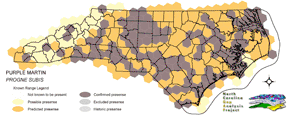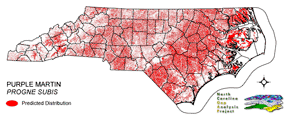
| Taxa: |
| Order: |
| Family: |
| Aves |
| Passeriformes |
| Hirundinidae |
| NatureServe Global Rank: |
| NatureServe State (NC) Rank: |
| G5 |
| S5B,SZN |
| Federal Status: |
| NC State Status: |
| --- |
| --- |


| Land Unit |
| US Fish & Wildlife Service |
| US Forest Service |
| US National Park Service |
| US Department of Defense |
| NC State Parks |
| NC University System |
| NC Wildlife Res. Com. |
| NC Forest Service |
| NC Div. of Coastal Mgmt. |
| Local Governments |
| Non-Governmental Org. |
| Other Public Lands |
| Private Lands |
| GAP Status 1-2 |
| All Protected Lands |
| Statewide |
| Hectares |
| 13,623.21 |
| 18,359.10 |
| 19,416.06 |
| 8,261.82 |
| 3,256.29 |
| 4,109.94 |
| 7,823.43 |
| 1,932.90 |
| 532.53 |
| 1,452.42 |
| 2,414.70 |
| 3,306.96 |
| 4,546,172.97 |
| 30,895.89 |
| 81,340.35 |
| 4,630,662.33 |
| Acres |
| 33,663.68 |
| 45,366.32 |
| 47,978.12 |
| 20,415.40 |
| 8,046.47 |
| 10,155.88 |
| 19,332.11 |
| 5,060.82 |
| 1,315.91 |
| 3,589.01 |
| 5,966.85 |
| 8,171.67 |
| 11,233,835.87 |
| 76,629.91 |
| 201,280.86 |
| 11,442,898.10 |
| % of Dist. on |
| Prot. Lands |
| 16.7 % |
| 22.6 % |
| 22.0 % |
| 10.2 % |
| 4.0 % |
| 5.1 % |
| 9.0 % |
| 2.4 % |
| 0.7 % |
| 2.8 % |
| 2.8 % |
| 3.2 % |
| < 0.1 % |
| 38.0 % |
| ----- |
| ----- |
| % of Dist. on |
| All Lands |
| 0.3 % |
| 0.4 % |
| 0.4 % |
| 0.2 % |
| < 0.1 % |
| < 0.1 % |
| 0.2 % |
| < 0.1 % |
| < 0.1 % |
| < 0.1 % |
| < 0.1 % |
| < 0.1 % |
| 98.2 % |
| 0.7 % |
| ----- |
| ----- |
|
Fairly common to common throughout the state, especially near the coast (Potter et al. 1980). Found primarily in towns, suburbs, and farmlands, especially near water, where it nests almost exclusively in bird houses and occasionally other man-made structures. Very rarely nests in its ancestral habitat of old woodpecker holes (Nicholson 1997). Nests in colonies (Ehrlich et al. 1988). Forages mostly while flying, sometimes over water; occasionally forages on the ground, especially in bad weather (Kaufman 1996). Drinks and bathes on the wing (Ehrlich et al. 1988). NATURE SERVE GLOBAL HABITAT COMMENTS: A wide variety of open and partly open situations, frequently near water or around towns (Subtropical and Temperate zones, in winter also Tropical Zone) (AOU 1983). South America: congregates in roosts in city plazas and parks (Ridgely and Tudor 1989). BREEDING: In west and formerly in east nests in tree cavities, abandoned woodpecker holes (including those in saguaro cacti), crevices in rocks; in east and midwest now nests in bird- houses and gourds put up by humans. |
| Code | Name | Description | NC Natural Heritage Program Equivalent |
| 372 | Interdune Herbaceous Wetlands | Dune swales with permanently flooded to intermittently exposed hydrology. Species composition depends on salinity and can include cut grass, spike-rush, mosquito fern, and hornwort. | Interdune Pond, Maritime Wet Grasslands |
| 371 | Maritime Grasslands | Dune grass community consisting of sea oats and beach grasses. | Dune grass, Maritime dry grassland |
| 380 | Coastal Plain Fresh Water Emergent | Emergent vegetation in fresh water seepage bogs, ponds and riverbeds of the coastal plain. Includes alliances dominated by sedges, eelgrass, as well as cane found in unforested cane-brakes. | Small Depression Pond, Sandhill Seep, Floodplain Pool, Unforested Floodplain Canebrake, Riverscour Prairies, Vernal Pools |
| 173 | Coastal Plain Riverbank Shrubs | Shrub dominated riverbanks, commonly dominated by willows and/or alders. | Sand and Mud Bar |
| 238 | Piedmont/Mountain Submerged Aquatic Vegetation | Seasonally to permanently flooded areas with aquatic vegetation. Waterlily, pondweed, hydrilla smartweed are a few of the species that can occur. | Piedmont/Mountain Semipermanent Impoundment (in part) |
| 239 | Piedmont/Mountain Emergent Vegetation | Emergent vegetation of all wetland hydrologies. Sites would commonly support species such as tussock sedge, rushs, and cattail alliances. | Rocky Bar and Shore (in part) |
| 267 | Riverbank Shrublands | Riverside shrubs with temporarily flooded hydrologies. Found in the both the Mountains and Piedmont. Containing dominants such as smooth alder and a Carolina or black willows. | Sand and Mud Bar |
| 269 | Floodplain Wet Shrublands | Saturated shrublands of the Piedmont, includes buttonbush, swamp-loosestrife, decodon and alders. | Piedmont/mountain Semipermanent Impoundment |
| 20 | Coniferous Regeneration | Regenerating pine stands. Predominantly loblolly pine, but slash and longleaf stands occur as well. | No equivalent |
| 36 | Successional Deciduous Forests | Regenerating deciduous trees with a shrub stature. Commonly dominated by sweetgum, tulip poplars and maples. | No equivalent |
| 180 | Agricultural Crop Fields | Farm fields used for row crops. | No equivalent |
| 205 | Agricultural Pasture/Hay and Natural Herbaceous | Farm fields used for pasture grass or hay production, as well as old fields dominated by native and exotic grasses. | No equivalent |
| 213 | Barren; quarries, strip mines, and gravel pits | Quarries, strip mines, or gravel pits. | No equivalent |
| 214 | Barren; bare rock and sand | Areas of bare rock, sand or clay. | No equivalent |
| 202 | Residential Urban | Includes vegetation interspersed in residential areas. Includes lawns, mixed species woodlots, and horticultural shrubs. Vegetation accounts for between 20 - 70% of the cover. | No equivalent |
| 203 | Urban Low-Intensity Developed | Highly developed areas with vegetation accounting for < 20% of the cover. | No equivalent |
| 8 | Open water | Open water without aquatic vegetation. | No equivalent |
|
Sheldon, F. H., and D. W. Winkler. 1993. Intergeneric phylogenetic relationships of swallows estimated by DNA-DNA hybridization. Auk 110:798-824.
Ehrlich, P.R., D.S. Dobkin, and D. Wheye. 1992. Birds in jeopardy:the imperiled and extinct birds of the United States and Canada, including Hawaii and Puerto Rico. Stanford University Press, Stanford, California. 259 pp. Hagan, J.M., III, and D.W. Johnston, editors. 1992. Ecology and conservation of neotropical migrant landbirds. Smithsonian Institution Press, Washington, D.C. xiii + 609 pp. Sauer, J.R., and S. Droege. 1992. Geographical patterns in population trends of neotropical migrants in North America. Pages 26-42 in J.M. Hagan III and D.W. Johnston, editors. Ecology and conservation of neotropical migrant landbirds. Smithsonian Institu Kaufman K. 1996. Lives of North American Birds. Boston, New York: Houghton Mifflin Company. Nicholson CP. 1997. Atlas of the breeding birds of Tennessee. Knoxville: University of Tennessee Press. Allen, R.P. and M.M. Nice. 1952. A study of the breeding biology of the purple martin (PROGNE SUBIS). Amer. Midland- Nat. 47(3):606-65. Oberholser, H.C. 1974. The bird life of Texas. 2 vols. Univ. of Texas Press, Austin. Bowditch, J. 1990. A way to stop crow and owl predation at purple martin houses. Purple Martin Update 2(3):8-9. Godfrey, W.E. 1966. The birds of Canada. National Museums of Canada. Ottawa. 428 pp. Ginaven, J. 1990. Using decoys to attract purple martins. Purple Martin Update 2(3):26-27. Wade, J. 1966. What you should know about the purple martin. 218 pp. Layton, R. B. 1969. The purple martin. Nature Books. 192 pp. Morton, E. S., and K. C. Derrickson. 1990. The biological significance of age-specific return schedules in breeding purple martins. Condor 92:1040-1050. Harrison, C. 1978. A field guide to the nests, eggs and nestlings of North American birds. Collins, Cleveland, Ohio. Potter, E. F., J. F. Parnell, and R. P. Teulings. 1980. Birds of the Carolinas. Univ. North Carolina Press, Chapel Hill. 408 pp. Terres, J.K. 1980. The Audubon Society encyclopedia of North American birds. Alfred A. Knopf, New York. American Ornithologists' Union (AOU), Committee on Classification and Nomenclature. 1983. Check-list of North American Birds. Sixth Edition. American Ornithologists' Union, Allen Press, Inc., Lawrence, Kansas. National Geographic Society (NGS). 1983. Field guide to the birds of North America. National Geographic Society, Washington, D.C. Hilty, S.L., and W.L. Brown. 1986. A guide to the birds of Colombia. Princeton University Press, Princeton, New Jersey. 836 pp. Ehrlich, P.R., D.S. Dobkin, and D. Wheye. 1988. The birder's handbook:a field guide to the natural history of North American birds. Simon and Shuster, Inc., New York. xxx + 785 pp. Mitchell, W.A. 1988. Songbird nest boxes. Section 5.1.8, U.S. Army Corps of Engineers, Wildlife Resources Management Manual. Tech. Rep. EL-88-19. Waterways Experiment Station, Vicksburg, Mississippi. 48 pp. Ridgely, R.S., and G. Tudor. 1989. The birds of South America. Vol. 1. The Oscine passerines. Univ. Texas Press, Austin. 516 pp. Stiles, F.G., and A.F. Skutch. 1989. A guide to the birds of Costa Rica. Comstock Publ. Associates, Cornell University Press, Ithaca, New York. 511 pp. Turner, A., and C. Rose. 1989. Swallows and martins an identification guide. Houghton Mifflin Co., Boston. Stutchbury, B. J. 1991. Coloniality and breeding biology of purple martins (PROGNE SUBIS HESPERIA) in saguaro cacti. Condor 93:666-675. |
For more information please contact them at:
NC-GAP Analysis Project
Dept. of Zoology, NCSU
Campus Box 7617
Raleigh, NC 27695-7617
(919) 513-2853
www.basic.ncsu.edu/ncgap